If I asked you to grab me a flathead screwdriver, chances are you would know what I’m talking about. Most would even know that the other screwdriver type that looks like a plus sign is called a Phillips. Some would know that I was simplifying by saying “the other type” because there are more than just those two: the square drive, hex, and the fancier Torx also exist. Beyond that is where we enter a more specialized territory where fewer and fewer people may be aware of anything different.
I would imagine that many will have never heard of screwdrivers called Hi-Torque, Pozidriv, Supadriv, Frearson, or Mortorq. Or how about the LOX-Recess, Triple-square, Pentalobe, clutch, Bristol, and Polydrive? Did you know there are the Tri-angle, Tri-point, Tri-groove, and Tri-wing screwdrivers? In fact, there are well over 50 standard styles with dozens more variations including tamper-resistant versions of the standards as well as one-way drivers.
Adding to the complexity, most of these standards come in a whole range of defined sizes with Torx offering more than 40 just for the regular internal and external shapes, not including half a dozen Torx variations. It’s incredibly difficult to get a count of exactly how many different screwdriver styles and sizes there are, but it is safe to say the number is in the multiple hundreds, possibly thousands.
Shall I blow your mind even more? This isn’t including proprietary screwdriver styles employed to prevent anyone from unscrewing something they shouldn’t be unscrewing, a great example being the Key-Rex used for ballot boxes and bank vaults with individually unique driver shapes that are designed exclusively for each customer like a key. Proprietary drivers are usually not sold to the public but only available for those licensed or qualified to work on equipment equipped with these types of screws.
What can make all of this ever more confusing is that the official names for some screwdriver styles have more common language or brand names attached to them as well. Take the Tri-point-3, which is also referred to as the TP3, Tri-lobular, and Tri-lobe for the exact same design.
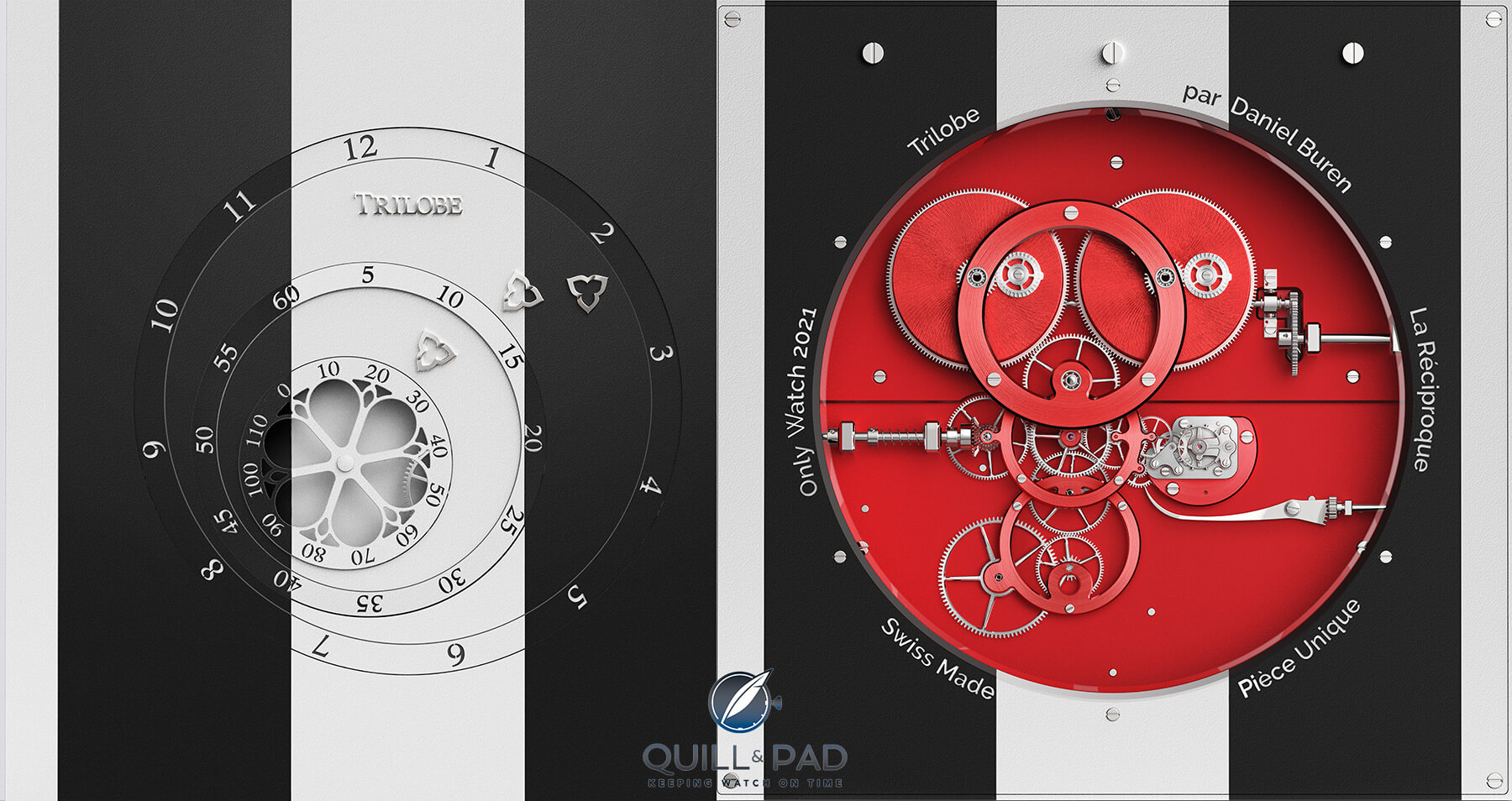
Front and back of the Trilobe x Daniel Buren La Réciproque clock for Only Watch 2021
I personally knew it as the Tri-lobe for years, which is why when I first heard of the new watch brand Trilobe I couldn’t help but think of the Reuleaux triangle-shaped screwdriver. But Trilobe watches are much, much more interesting. This can be seen best with Trilobe’s entry in the 2021 Grand Prix d’Horlogerie de Genève (GPHG) and the upcoming Only Watch 2021 charity auction.
Trilobe Nuit Fantastique: now competing in the GPHG
Trilobe is a unique brand that doesn’t stick with the classics, but is instead built around an idea of changing how we experience time and the reading of it. Its first watch, Les Matinaux, utilized two non-concentric but tangent rings and a disk to show time traveling past fixed points on the dial. Since these were completely visible, and the indicators didn’t line up or point in the same direction, reading the time was intended to be a deliberate act rather than a passing glance. It was about experiencing time.
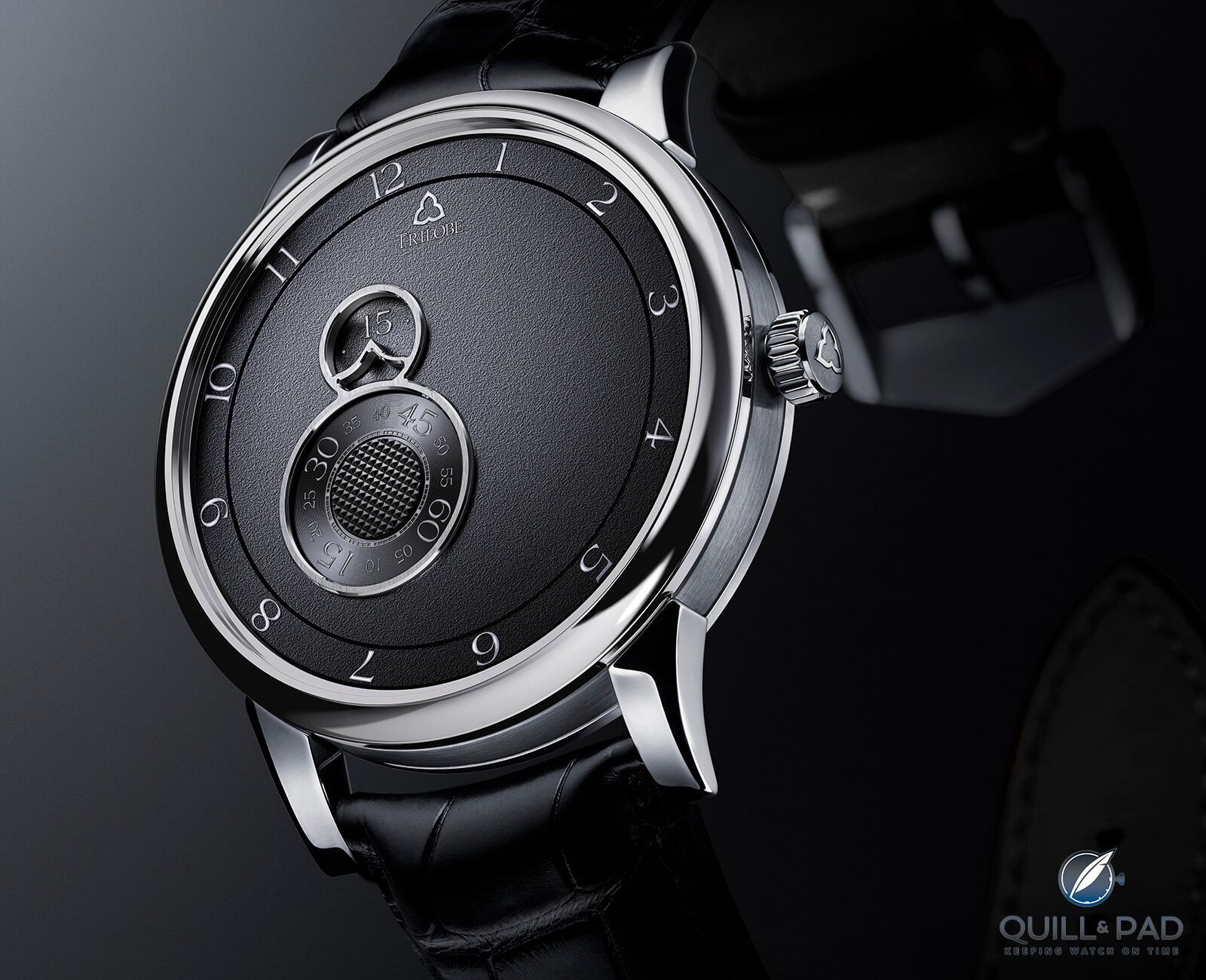
Trilobe Nuit Fantastique
A new piece, Nuit Fantastique, entered into the 2021 Grand Prix d’Horlogerie de Genève’s Petite Aiguille category, represents the next step in aesthetic direction for Trilobe. Nuit Fantastique takes the concept of Les Matinaux in a slightly different direction, which makes it a bit easier to differentiate the time with a cleaner layout. But the idea is still the same as is the base movement.
Nuit Fantastique still uses the same type of rings and a disk to tell the time, but the presentation has been modified to make an even more attention-grabbing dial.
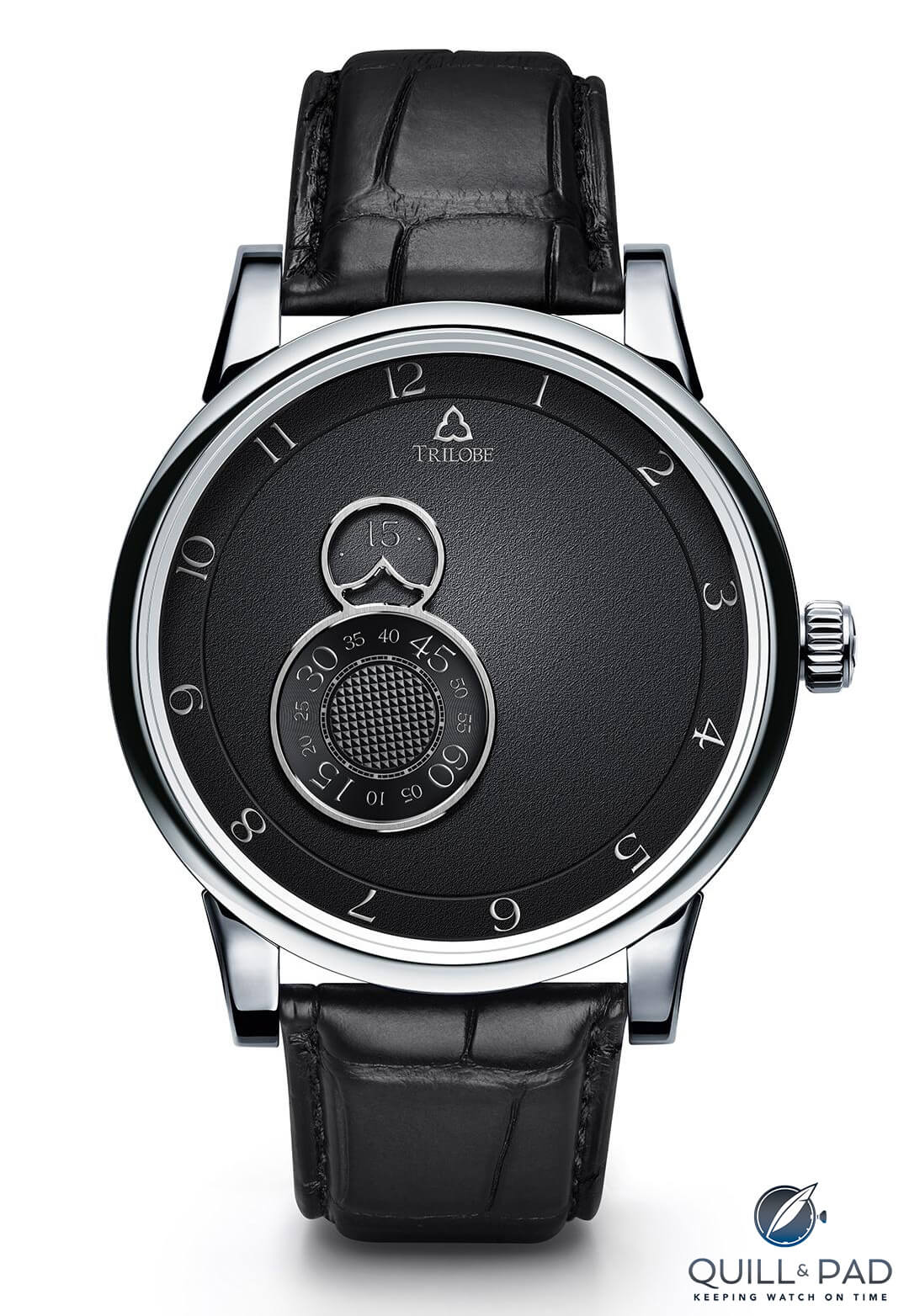
Trilobe Nuit Fantastique
The hours are displayed on an outer ring that runs along the edge of the dial, just like on Les Matinaux, but this time the Trilobe logo (which has always acted as an indicator) is positioned perfectly at 12 o’clock instead of 2 o’clock. This makes reading the hours much more intuitive while maintaining the regulator nature of the watch. The minutes and seconds are displayed via rings left of center: the minutes are seen through an aperture resting atop the running seconds dial.
The ring is continuously moving and slowly passes by the opening while small, polished dots between the five-minute increments of the minute ring show that the aperture is not centered at the top but along the upper left portion. This may be trivial to some, but it showcases how a brand can design what appears to be a completely different dial while using the same underlying structure.
Clean architecture
The continuously running seconds disk, previously openworked to highlight the watch’s inner mechanics, has been modified with a central section of clous de Paris guilloche. Outside of the pattern is a small railroad track chapter ring for the individual seconds followed by numerals that alternate between small and large, drawing attention to the quarters.
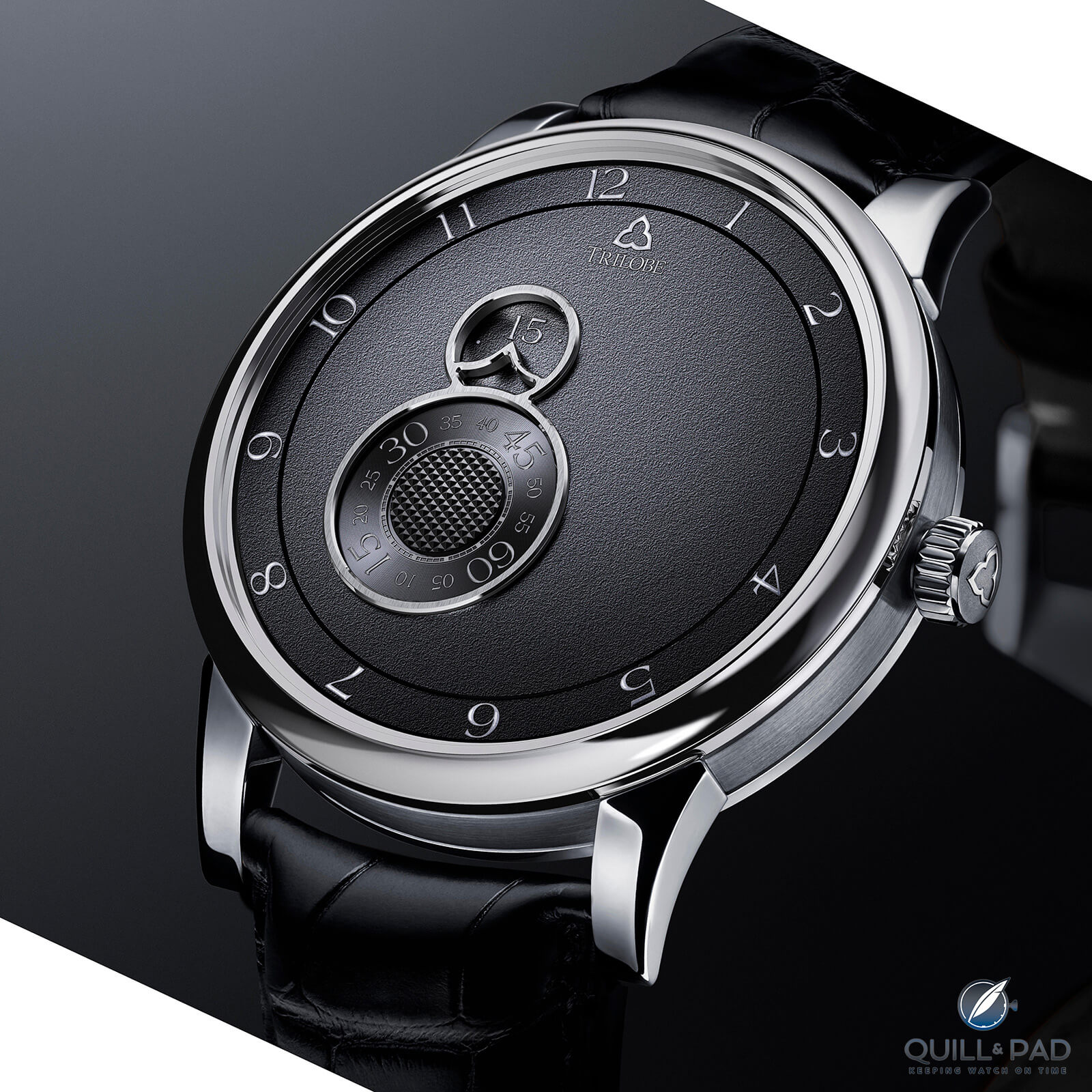
Trilobe Nuit Fantastique
This new arrangement of the dial with a frame surrounding the minutes and seconds also does away with the multiple logos as indicators. The hour ring is the only one; the minutes are indicated by a pointed feature on the frame; and the seconds have no reference mark, simply rotating as they wish, with no way to precisely decide what second it is. Perfect for this type of watch.
The movement inside, developed with Chronode, is dubbed Caliber X-Centric for the eccentric nature of the rings as well as the design philosophy. It boasts a micro rotor at 12 o’clock and the balance wheel at 6 o’clock, symmetrically balanced around a central wheel that allows one to peer into the mechanics. The main plate and balance bridge reflect the modern aesthetic the brand prefers, while the simple yet clean construction is emblematic of Trilobe.
Trilobe x Daniel Buren La Réciproque for Only Watch 2021
Trilobe’s creation for the 2021 Only Watch charity watch auction was made in collaboration with French conceptual artist Daniel Buren, Trilobe created a clock based on the layout of Les Matinaux with an aesthetic designed to jar you awake. Buren is best known for painting vertical stripes and plastering them on buildings, billboards, and other public sights since 1965. This very simple and ridged architectural style matched with Trilobe like the slant rhyme of the words fruit and foot.
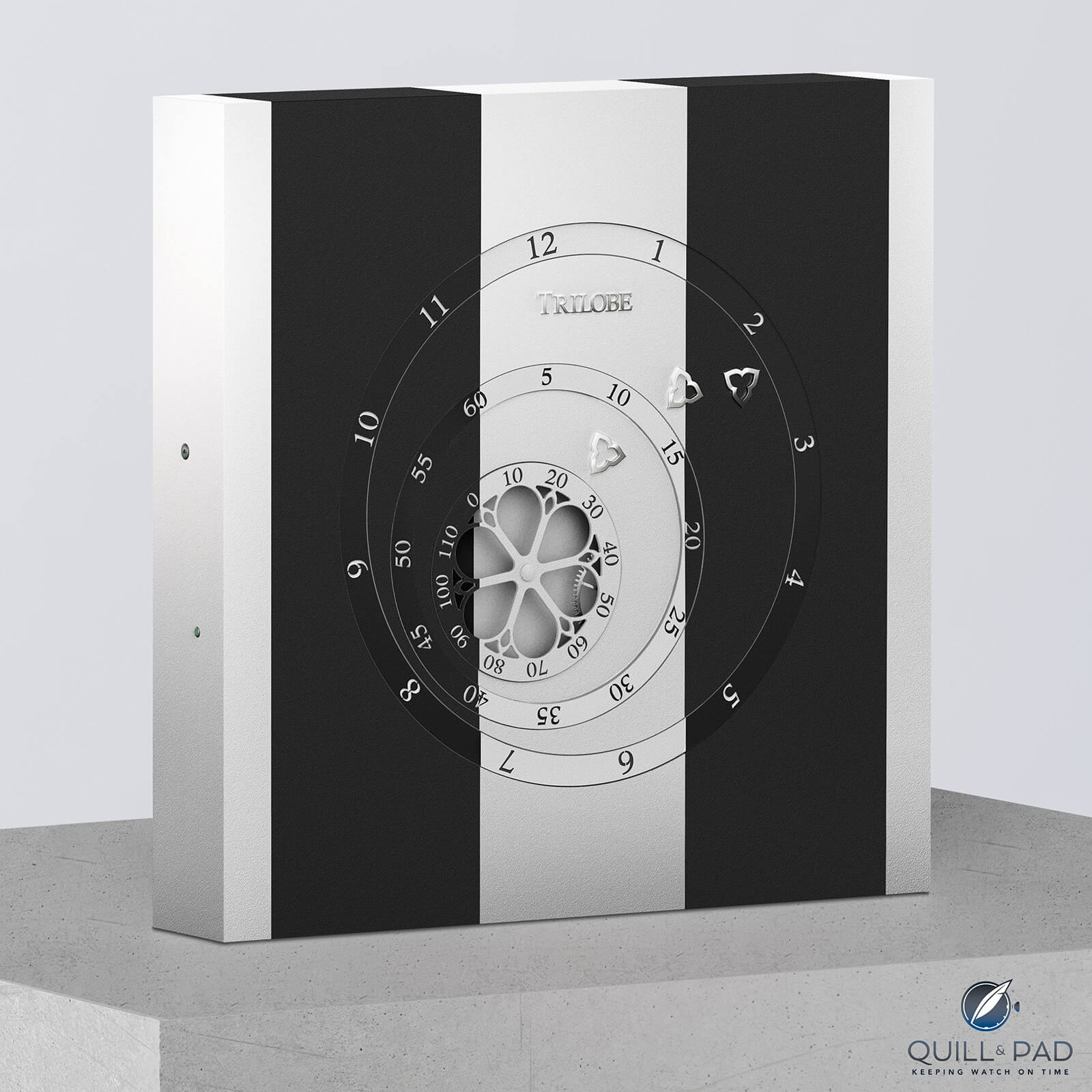
Trilobe x Daniel Buren La Réciproque clock for Only Watch 2021
One is all about straight lines, the other about eccentric circles and clean edges, so they mesh well but not perfectly. La Réciproque is thus styled to advantage with a frame featuring large vertical black and white stripes. In its center, we find the time display from Les Matinaux: three sets of eccentric rings displaying the hours, minutes, and seconds. But instead of existing outside of the bold vertical stripes, the rings are painted to match and align so that only once every 12 hours do the rings align perfectly.
The effect is stunning and creates a sense of day-long anticipation as one waits for the rings to align just right for a single second only to continue on their journey. The strangest aspect of that alignment is that it isn’t at midnight or noon, but 2:13 thanks to the positions of the hour and minute indicators from Les Matinaux. With all that, one might expect the dial to be the highlight, but the movement gives the design a run for its money.
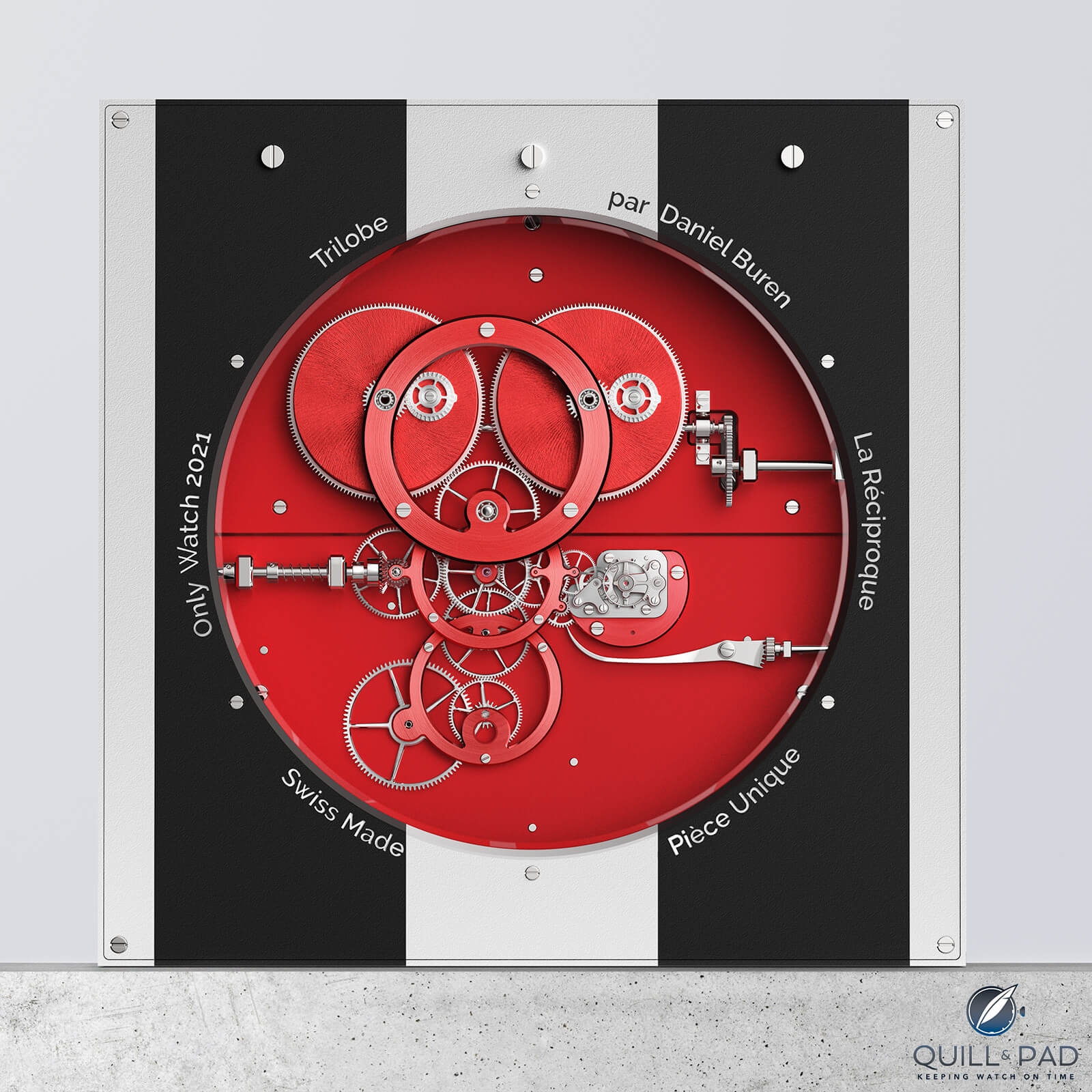
Movement side of the Trilobe x Daniel Buren La Réciproque clock for Only Watch 2021
The first thing you notice when you turn La Réciproque around is the gorgeous scarlet and polished steel movement finish, a blast of color after the black and white front of the clock. The layout of the gear train with its double mainspring barrels and repeated overlapping circles makes for a visually engaging movement that might be more attention-grabbing than the front – and that is saying something.
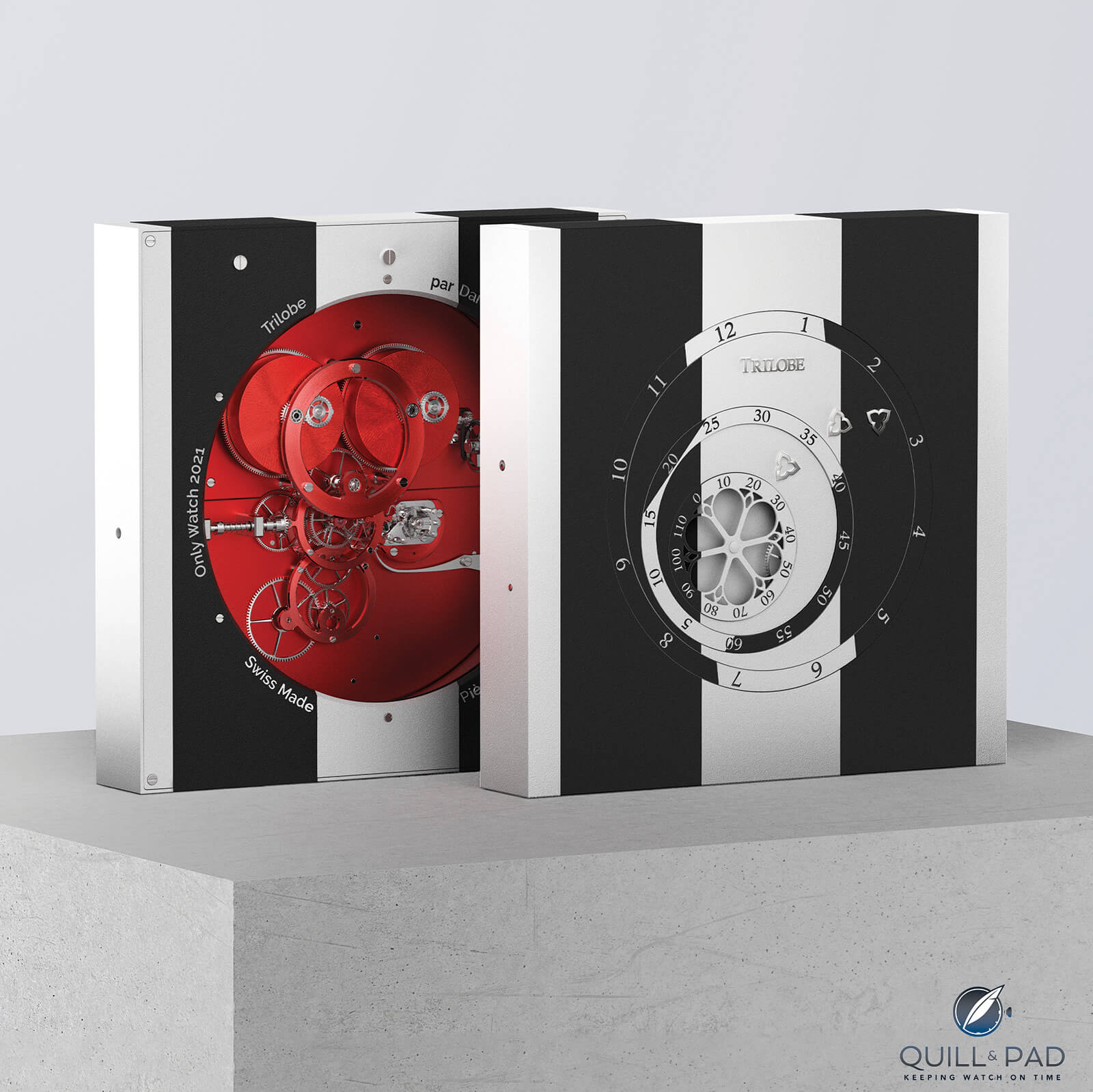
Front and back of the Trilobe x Daniel Buren La Réciproque clock for Only Watch 2021
In reality, it’s the contrast between the front and back that makes them both stand out, that and the superb finishing of the movement components. It’s clear that the clock is a work of art from both sides, meaning La Réciproque deserves to be the center of a room and never on a mantel unless it is in front of a mirror.
The clock and collaboration with Daniel Buren are mechanical and visual slant rhymes, and I’m certain the reception of this clock will spark even more interest in the watches from the brand.
Both La Réciproque for Only Watch and Nuit Fantastique as seen in the 2021 Grand Prix d’Horlogerie de Genéve are incredible examples of a simple idea taken to beautiful extremes for peak visual appeal. Trilobe isn’t trying to fit anyone’s expectations of what a watch should be. Yet Nuit Fantastique remains supremely wearable. Just don’t hurry: take your time to tell the time.
For more information, please visit trilobe.com/us/nuit-fantastique-collection and onlywatch.com/trilobe.
Quick Facts Trilobe Nuit Fantastique
Case: 40.5 x 9.2 mm, stainless steel
Movement: automatic Chronode X-Centric caliber with micro rotor, 48-hour power reserve, 28,800 vph/4 Hz frequency
Functions: hours, minutes seconds
Price: $10,560 / 9,100 Swiss francs in blue, black, or silver; $13,560 with customized astronomical dial
Quick Facts Trilobe x Daniel Buren La Réciproque for Only Watch 2021
Case: 300 x 300 x 51.5 mm, aluminum
Movement: manual winding D-Centric caliber, 8-day power reserve, 18,000 vph/2.5 Hz frequency
Functions: hours, minutes, seconds
Limitation: one unique piece
Auction estimate: 35,000 – 40,000 Swiss francs
You may also enjoy:
ArtyA Purity Tourbillon: Science Fiction Turned Science Fact
Complete Listing And Live Photos Of All 50 Timepieces In The 2019 Only Watch Charity Auction





















































Leave a Reply
Want to join the discussion?Feel free to contribute!